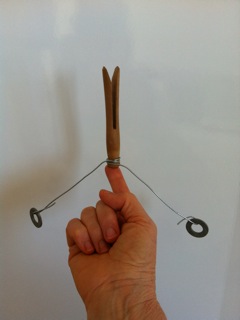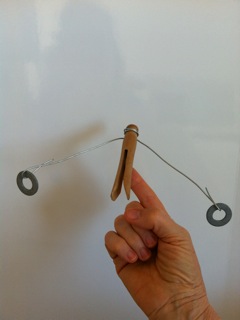Discover Primary Physics: Highlights of Book 1
THE PRIMARY PHYSICS SYSTEM
We begin by creating science as a game. When you play a game of checkers, there are black checkers and red checkers. If you want to play the game, you need to know that the checkers only move forward, they become a king when they get to the other side of the board, etc. In the same way, we have basic pieces in the game of science. In the case of physics, long regarded as the most fundamental of all, they are mass, energy and forces. We have to know the properties of mass, energy and forces before we can play the game.
What I have discovered through many years of teaching physics to young children is that if they do an activity and can see the answer, they will remember it. If they do several such activities in a row, they begin to develop a certainty and an understanding about the rules of the physical world, and a certainty about themselves as being capable. It works.
I am going to show you the method I use in “Primary Physics Book 1”, and then you will be able to use this as a template to determine sequences of your own. I am going to suggest a starting point and then follow it with a series of activities that flow logically and move forward along a through line in very small increments. The result is a deep understanding of the topic, and a sound, certain platform.
The key to success in this game is to design activities using things with which the children are familiar and to move on in very small steps. Lots of small steps. Do not be afraid that you are not dazzling children by blowing up something. You can engage them by getting them to focus on the details of everyday things. The rewards are long lasting and children will genuinely understand the rules of the physical world.
PLAYING THE GAME TO WIN
The place to start any game is at the beginning. In the physics game, start with ‘mass’, the physical stuff that makes up the world in which we live. Have each child do each activity listed below.
Identify that mass has observable properties. (STe- 9ME) (ACSSU003)
- Put numerous objects of different sizes and types of material in a large cardboard box, with a hole cut for a hand to fit through. As each object is pulled out, students observe the qualities of the different types of mass, what is similar and what is different about each. They can discuss, group, and draw them. (critical and creative thinking) (ACSIS011, ACSHE013, ACSIS233) (I) (WS)
Observe that one property of Mass is that it takes up space. (STe-9ME) (ACSSU003) –
- Start with one flat coin, or counter. Add more on top, one-by-one, so that a tall pile forms. Repeat to make several piles. Observe that a pile of coins takes up more space than an individual coin. Count the number of coins in each pile to determine how many times more space the pile takes up than the single coin. (numeracy) (critical and creative thinking) (ST1-4WS)
Observe that another property of Mass is that it has volume. (numeracy) (ACSSU005) (STe- 9ME) (ST1-4WS)
- Fill a small container with marbles. Pour them into a larger container. Repeat until the larger container is full. How many times does the small container get filled in order to fill the larger one? Which container has more volume? Draw a diagram to show your result. (numeracy) (literacy) (I) (ST1-4WS)
Observe that a further property of Mass is that it has a centre on which it balances (centre of Mass). (ACSSU005) (STe-9ME)
- Balance various objects on your finger. (work and enterprise) (STe-6NE)
- Make a balancing toy out of a dolly peg, stiff wire, and two washers (see photos). Balance it on your finger. Change the position of the wires. Again balance it on your finger. What do you observe? Explain. (literacy) (STe- 6NE) (work and enterprise) (critical and creative thinking) (ST2-4WS)


Observe that one more property of Mass is that it has density. (ACSSU003) (STe-9ME)
- Get equal sized squares of paper and aluminium foil. Squeeze each of them into a ball as tightly as possible. Compare them. Which one can be packed most tightly or densely? Explain why you think this happens. (ST2-4WS) (STe-9ME) (critical and creative thinking) (literacy)
- Chew a small piece of pumpernickel bread and a small piece of white bread. Which one is more dense? Explain why. (STe-9ME) (critical and creative thinking) (ST2-4WS)
Observe that Forces act on Mass. (STe-9ME) (ACSSU003) (ST1-7PW) (ST2-7PW)
- Friction acts when two masses are in contact with each other. (work and enterprise) (ST1-7PW) (ST2-7PW) (STe-6NE)
- Slide a small, flattened ball of dough along a table. What do you observe? Explain and draw a diagram. (ST2-7PW) (critical and creative thinking) (literacy) (ST2-4WS) (I)
- Use a crayon, pencil and chalk to draw on a piece of paper, then a piece of waxed paper, and finally a piece of sandpaper. What do you observe? Explain. (critical and creative thinking) (literacy) (ST2-7PW)(ST2-4WS)
- Gravity acts on Mass over a distance. (literacy) (STe-6NE) (ST2-7PW)
- Slide a small ball of dough along the table until it drops off the edge. What do you observe? Why do you think this happens? (literacy)(critical and creative thinking)(STe-6NE) (STe-9ME)(ST2- 7PW)(ST2-4WS)
- Drop a large ball of dough from 30 cm. What happens to its shape? Now carefully stand on a chair and drop the ball from the height of your extended arms. What happens to its shape? Why do you think this happens? (work and enterprise) (literacy)(critical and creative thinking)(ST2- 7PW)(ST3-4WS)
- Drop two marbles of the same size at the same time (practice letting go at the same time). What happens? Now drop a large and a small marble at the same time. What happens? Does size of the Mass make a difference? (critical thinking) (literacy)(STe-6NE)(STe-9ME)(ST3-4WS) (ST1-7PW)
- Drop a marble and a tissue at the same time. What happens? Now, scrunch up the tissue and drop them both at the same time. What happens? Does the shape of the Mass make a difference? (critical and creative thinking)(literacy)(STe-6NE)(STe- 9ME)(ST1-7PW)(ST3-4WS)
Once you get the idea of moving in very small increments, along a logical path, using the basic pieces, you have the key to the physics game. Be sure to have plenty of awards and stickers on hand. You’ll need them because you will create many winners.
“Primary Physics” is an international award-winning series of workbooks for students and teachers that uses the method of building understanding through taking small, incremental steps. Fitting in with the Australian Curriculum, the “Primary Physics” series of six workbooks provides an effective process to achieve genuine understanding of the laws of the physical world. And no one thinks it’s hard.
